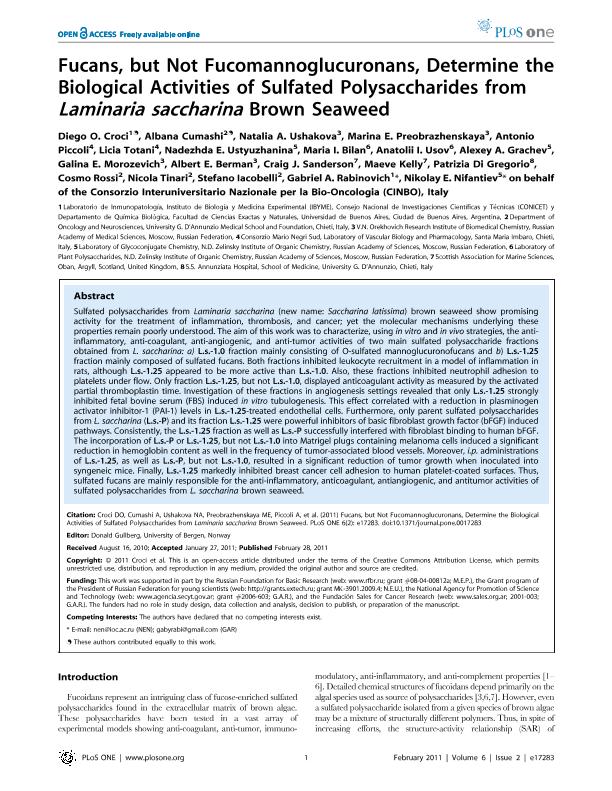Artículo
Fucans, but not fucomannoglucuronans, determine the biological activities of sulfated polysaccharides from Laminaria saccharina brown seaweed
Croci Russo, Diego Omar ; Cumashi, Albana; Ushakova, Natalia A.; Preobrazhenskaya, Marina E.; Piccoli, Antonio; Totani, Licia; Ustyuzhanina, Nadezhda E.; Bilan, María I.; Usov, Anatolii I.; Grachev, Alexey A.; Morozevich, Galina E.; Berman, Albert E.; Sanderson, Craig J.; Kelly, Maeve; Di Gregorio, Patrizia; Rossi, Cosmo; Tinari, Nicola; Iacobelli, Stefano; Rabinovich, Gabriel Adrián
; Cumashi, Albana; Ushakova, Natalia A.; Preobrazhenskaya, Marina E.; Piccoli, Antonio; Totani, Licia; Ustyuzhanina, Nadezhda E.; Bilan, María I.; Usov, Anatolii I.; Grachev, Alexey A.; Morozevich, Galina E.; Berman, Albert E.; Sanderson, Craig J.; Kelly, Maeve; Di Gregorio, Patrizia; Rossi, Cosmo; Tinari, Nicola; Iacobelli, Stefano; Rabinovich, Gabriel Adrián ; Nifantiev, Nicolay E.
; Nifantiev, Nicolay E.
 ; Cumashi, Albana; Ushakova, Natalia A.; Preobrazhenskaya, Marina E.; Piccoli, Antonio; Totani, Licia; Ustyuzhanina, Nadezhda E.; Bilan, María I.; Usov, Anatolii I.; Grachev, Alexey A.; Morozevich, Galina E.; Berman, Albert E.; Sanderson, Craig J.; Kelly, Maeve; Di Gregorio, Patrizia; Rossi, Cosmo; Tinari, Nicola; Iacobelli, Stefano; Rabinovich, Gabriel Adrián
; Cumashi, Albana; Ushakova, Natalia A.; Preobrazhenskaya, Marina E.; Piccoli, Antonio; Totani, Licia; Ustyuzhanina, Nadezhda E.; Bilan, María I.; Usov, Anatolii I.; Grachev, Alexey A.; Morozevich, Galina E.; Berman, Albert E.; Sanderson, Craig J.; Kelly, Maeve; Di Gregorio, Patrizia; Rossi, Cosmo; Tinari, Nicola; Iacobelli, Stefano; Rabinovich, Gabriel Adrián ; Nifantiev, Nicolay E.
; Nifantiev, Nicolay E.
Fecha de publicación:
28/02/2011
Editorial:
Public Library Of Science
Revista:
Plos One
e-ISSN:
1932-6203
Idioma:
Inglés
Tipo de recurso:
Artículo publicado
Clasificación temática:
Resumen
Sulfated polysaccharides from Laminaria saccharina (new name: Saccharina latissima) brown seaweed show promising activity for the treatment of inflammation, thrombosis, and cancer; yet the molecular mechanisms underlying these properties remain poorly understood. The aim of this work was to characterize, using in vitro and in vivo strategies, the anti-inflammatory, anti-coagulant, anti-angiogenic, and anti-tumor activities of two main sulfated polysaccharide fractions obtained from L. saccharina: a) L.s.-1.0 fraction mainly consisting of O-sulfated mannoglucuronofucans and b) L.s.-1.25 fraction mainly composed of sulfated fucans. Both fractions inhibited leukocyte recruitment in a model of inflammation in rats, although L.s.-1.25 appeared to be more active than L.s.-1.0. Also, these fractions inhibited neutrophil adhesion to platelets under flow. Only fraction L.s.-1.25, but not L.s.-1.0, displayed anticoagulant activity as measured by the activated partial thromboplastin time. Investigation of these fractions in angiogenesis settings revealed that only L.s.-1.25 strongly inhibited fetal bovine serum (FBS) induced in vitro tubulogenesis. This effect correlated with a reduction in plasminogen activator inhibitor-1 (PAI-1) levels in L.s.-1.25-treated endothelial cells. Furthermore, only parent sulfated polysaccharides from L. saccharina (L.s.-P) and its fraction L.s.-1.25 were powerful inhibitors of basic fibroblast growth factor (bFGF) induced pathways. Consistently, the L.s.-1.25 fraction as well as L.s.-P successfully interfered with fibroblast binding to human bFGF. The incorporation of L.s.-P or L.s.-1.25, but not L.s.-1.0 into Matrigel plugs containing melanoma cells induced a significant reduction in hemoglobin content as well in the frequency of tumor-associated blood vessels. Moreover, i.p. administrations of L.s.-1.25, as well as L.s.-P, but not L.s.-1.0, resulted in a significant reduction of tumor growth when inoculated into syngeneic mice. Finally, L.s.-1.25 markedly inhibited breast cancer cell adhesion to human platelet-coated surfaces. Thus, sulfated fucans are mainly responsible for the anti-inflammatory, anticoagulant, antiangiogenic, and antitumor activities of sulfated polysaccharides from L. saccharina brown seaweed.
Palabras clave:
Fucose
,
Angiogenesis
,
Endothelial Cells
,
Saccharina
Archivos asociados
Licencia
Identificadores
Colecciones
Articulos(IBYME)
Articulos de INST.DE BIOLOGIA Y MEDICINA EXPERIMENTAL (I)
Articulos de INST.DE BIOLOGIA Y MEDICINA EXPERIMENTAL (I)
Citación
Croci Russo, Diego Omar; Cumashi, Albana; Ushakova, Natalia A.; Preobrazhenskaya, Marina E.; Piccoli, Antonio; et al.; Fucans, but not fucomannoglucuronans, determine the biological activities of sulfated polysaccharides from Laminaria saccharina brown seaweed; Public Library Of Science; Plos One; 6; 2; 28-2-2011; e17283-e17283
Compartir
Altmétricas



